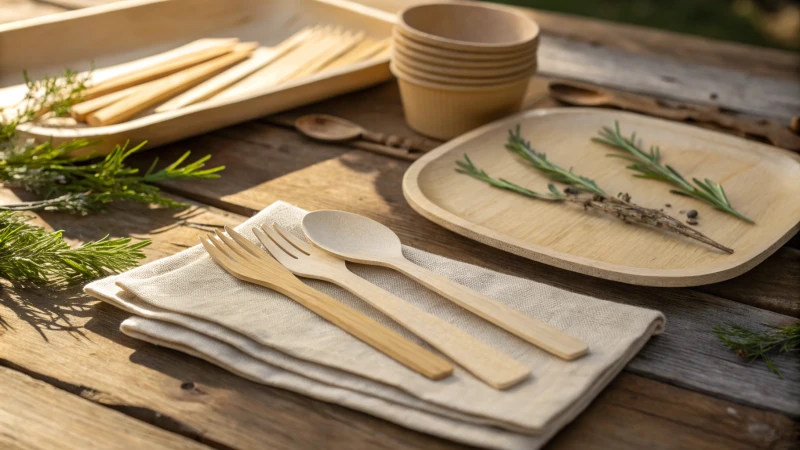
Have you ever thought about whether wooden cutlery really stands up to metal or plastic at your dinner table?
Disposable wooden cutlery provides a green option. It suits the environment and keeps everyone safe. Tough meals can challenge its strength. This cutlery breaks down naturally and looks nice. It serves people looking for earth-friendly choices. It looks good. Metal cutlery works better for some tasks, but wooden cutlery still stands out.
Using wooden cutlery seems like a small change but adds a meaningful touch to sustainability. I remember a picnic where I brought wooden forks. They worked perfectly with salads. Cutting a well-done steak, however, was a bit hard. Now, let's look at how wooden cutlery compares to metal and plastic in strength, ease of use, effect on nature and appearance.
Wooden cutlery is more eco-friendly than plastic.True
Wooden cutlery is biodegradable and compostable, unlike plastic.
Metal cutlery is less durable than wooden cutlery.False
Metal utensils are known for their strength and durability.
What Are the Environmental Benefits of Wooden Cutlery?
Have you ever thought about how using different utensils might help protect the Earth?
Wooden cutlery is good for the planet. It comes from resources that grow back. It breaks down easily and can turn into compost. People use less oil and gas for making it compared to plastic. This cuts down harmful gas and keeps nature cleaner.
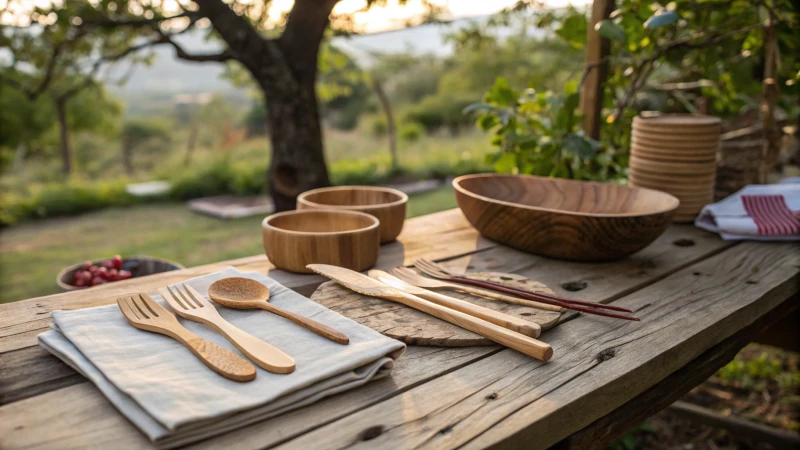
Renewable Resources
I remember the first time I held a wooden spoon at an outdoor event. It felt different, almost like it held the spirit of nature. Wooden tools come from fast-growing trees like birch and bamboo. These resources are renewable1 and collected carefully from the forest. Compared to plastic cutlery, which relies on finite fossil fuels, wooden utensils offer a sustainable option that regenerates naturally.
Biodegradability and Compostability
The idea of plastic staying around for hundreds of years is scary, isn't it? Unlike plastic cutlery, which can take hundreds of years to decompose, wooden cutlery is biodegradable. This means it breaks down naturally into the soil within a few months, leaving no harmful residue behind. Moreover, many wooden utensils are compostable2, meaning they can mix with food waste and improve the soil while reducing landfill waste.
Reduced Carbon Footprint
Creating wooden cutlery uses much less energy than plastic. The production process emits fewer greenhouse gases, contributing to a lower carbon footprint3. Plus, trees absorb CO2 as they grow, offsetting some of the emissions from making and moving these products. Forests help with our carbon levels—really, they do.
A Comparative Look: Wooden vs. Plastic and Metal Cutlery
| Aspect | Wooden Cutlery | Plastic Cutlery | Metal Cutlery |
|---|---|---|---|
| Source Material | Renewable wood | Non-renewable petroleum | Extracted metals like stainless steel |
| Decomposition | Biodegradable & compostable | Not biodegradable | Reusable but not decomposable |
| Environmental Impact | Low carbon footprint | High carbon footprint | Moderate; requires mining and processing |
| Reusability | Single-use but eco-friendly disposal | Single-use, contributes to waste | Long-term use but requires energy-intensive recycling |
Supporting Sustainable Practices
Many businesses focus on careful tree cutting and fair work conditions. This ensures that making wooden cutlery helps both nature and people by supporting sustainable harvesting and ethical labor practices. By choosing wooden utensils4, consumers contribute to a broader movement toward sustainability in everyday life—a small change with a very big effect that shows our values and our promise to care for the Earth for those who come after us.
Wooden cutlery is biodegradable and compostable.True
Wooden cutlery is made from renewable resources, making it eco-friendly.
Metal cutlery contributes to plastic waste.False
Metal cutlery is reusable, thus it doesn't add to plastic waste.
Is Wooden Cutlery Durable and Functional Enough for Everyday Use?
Picture yourself at a picnic table, nature all around, enjoying a meal with tools that care for the planet. Wooden cutlery could be that ideal choice for those who care about the environment.
Wooden cutlery works well for light meals. It matches green values. However, it struggles with hard foods. Metal utensils perform better with such foods. Wood offers a sustainable choice. It looks nice and feels comfortable.
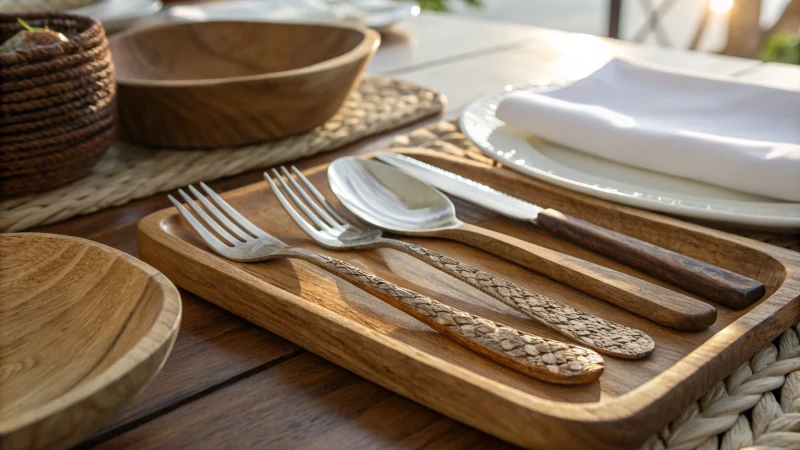
Discovering Durability
Each time I grab a wooden fork, memories of a summer barbecue flood my mind. Wooden utensils surprised me by handling potato salad and baked beans well. However, they struggled with cutting juicy steak. This moment showed me that durability depends on the type of wood and its crafting.
| Material | Durability Level |
|---|---|
| Wood | Moderate - Best for soft food |
| Metal | High - Suitable for all foods |
Wooden cutlery suits softer foods like pasta or salad. But, hearty meat requires something stronger, like metal. Metal cutlery5 easily handles all meals. It never falters.
Understanding Functionality
I first used a wooden spoon to prepare soup. Stirring fresh veggies felt calm and nice. Wooden utensils excel at mixing and serving soft dishes.
However, slicing firm foods with a wooden knife resembles using a butter knife - a bit annoying if you’re in a rush.
Metal knives6 cut seamlessly through thick textures, perfect for tough meals.
Despite difficulties, I love the green appeal of wooden cutlery. Their rustic look gives a special touch to dining, turning it into an experience.
Weighing Comfort and Safety
Wooden cutlery feels smooth - no sharp edges, safe for all, especially kids. I remember my niece eating safely with a wooden fork while I watched her use a metal one nervously.
| Aspect | Wood | Metal |
|---|---|---|
| Comfort | Smooth, lightweight | Heavier, potential sharpness |
| Safety | Safer edges | Requires careful handling |
Wooden cutlery is gentle and light; comfort during long meals increases.
In summary, wooden cutlery may not compete with metal in strength or function but remains my favorite due to their eco-friendly nature and aesthetic charm. For lighter meals where the environment is key, wooden utensils7 shine brightly.
Wooden cutlery is more eco-friendly than plastic.True
Wooden cutlery is biodegradable, reducing environmental impact compared to non-biodegradable plastic.
Metal cutlery is less durable than wooden.False
Metal cutlery is highly durable and can handle all food types without breaking.
Is Wooden Cutlery Safe and Comfortable for Everyday Use?
Ever wondered if wooden cutlery fits naturally into your daily meals? Let's explore its safety and comfort. See if it's the green hero we've been eager to find.
Wooden cutlery provides safety and comfort for daily meals. It feels light in the hand. The surface is smooth. There are no sharp corners on it. This design lowers the chance of injury. Wooden forks and knives cannot easily cut tough foods.
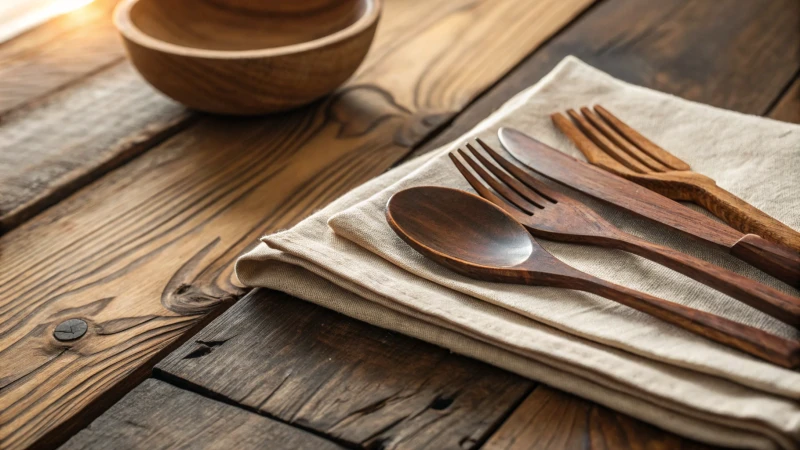
Safety Thoughts
Safe Materials: I remember when I first started using wooden forks and spoons at home. I mostly did it to live in a way that harms the planet less. It felt like the right move for my family. I felt good thinking about using tools without harmful chemicals, especially since my kids might chew on them accidentally. Plus, these are from natural materials, which is really nice.
Safe Edges: One time, I cut my finger on a metal knife. So, it was a relief to see wooden utensils usually have round edges. Such accidents seem less likely now. They are a great choice for homes with kids or older adults.
Comfort Parts
Lightweight and Easy Grip: After a long day, no one wants to fight heavy silverware. Wooden tools are wonderfully light. My grandma often mentions how easy they are to hold compared to our old metal ones.
Smooth Feel: There's a calm feeling to the smooth touch of wooden utensils. It's a bit like having a piece of nature at the table and very different from the sharp edges of plastic forks and knives.
| Aspect | Wooden Cutlery | Metal Cutlery | Plastic Cutlery |
|---|---|---|---|
| Weight | Lightweight | Heavy | Light |
| Edge Safety | Rounded, smooth | Sharp edges | Rough edges |
| Eco-Friendliness | High | Medium | Low |
Practical Challenges
As much as I like wooden tableware, they have their limits. Cutting a steak with a wooden knife? Tough job. Metal knives work better for that. But for everyday meals, they work just fine.
Also, I love that they break down naturally, but they require the right conditions to do so. Understanding local compost8 rules became important when I switched to wooden.
Environmental Effects
The nicest thing about wooden cutlery is helping the earth stay healthy. Made from resources that grow back and break down easily, I'm very focused on using less plastic.
But it’s probably important to pick wood from places that don’t harm the environment. Looking for signs of sustainable sourcing9 is very reassuring.
In the end, using wooden forks and spoons is a positive shift for my home. They feel safe, are very comfortable and fit my desire to protect the earth. They might not handle every cooking need, but they’re a green choice I’m happy to use every day.
Wooden cutlery is safer for children than metal.True
Wooden cutlery lacks sharp edges, reducing the risk of cuts.
Plastic cutlery is more environmentally friendly than wooden.False
Plastic is non-biodegradable, whereas wooden cutlery is compostable.
How Does Wooden Cutlery Transform Your Dining Experience?
Wooden cutlery is eco-friendly. It transforms meals into experiences with a rustic charm. These forks, knives and spoons probably bring a cozy feel to every meal. They might be the missing piece in your dinner party's puzzle. Yes, maybe they are.
Wooden cutlery improves dining aesthetics with a rustic and stylish look. It easily matches different table arrangements. Its natural feel and warm colors contrast nicely with usual metal or plastic utensils. This creates a welcoming dining environment.
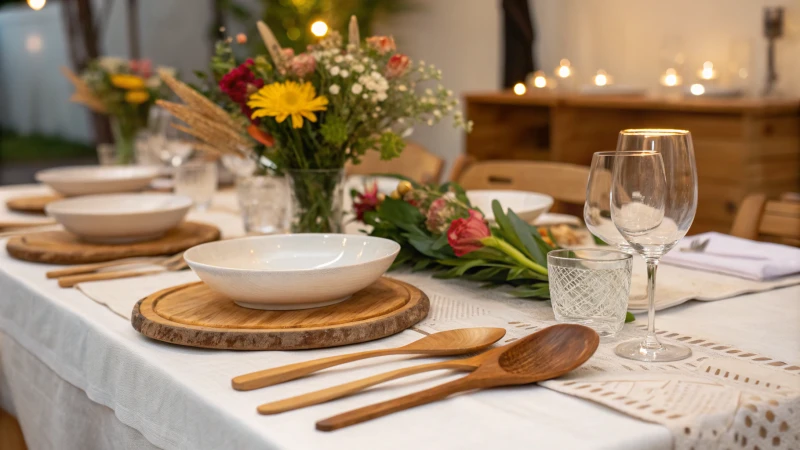
The Aesthetic Appeal of Wooden Cutlery
Wooden cutlery always feels warm and inviting to me. It probably brings back memories of cozy family dinners at my grandparents' home. These times were always special. Wooden utensils show their natural grain and earthy colors, making a simple meal look really nice. They create a sense of nature at the table, offering a cozy and rustic feel.
Moreover, wooden utensils are versatile in design, seamlessly fitting into both casual and formal dining settings. Their organic look pairs well with sustainable tableware10 like bamboo plates or linen napkins, enhancing the overall presentation.
Complementing Various Dining Themes
I love wooden cutlery because it fits different occasions. Whether you're hosting a garden party or an intimate dinner, wooden cutlery can enhance the aesthetic value. For themed events such as rustic weddings or eco-friendly gatherings, these utensils add an authentic touch that aligns with the event's ethos.
A comparative table showcasing how wooden cutlery fits different themes:
| Event Type | Wooden Cutlery Benefits |
|---|---|
| Rustic Weddings | Complements the natural decor |
| Beach Parties | Lightweight and easy to handle |
| Eco-Gatherings | Reflects commitment to sustainability |
| Corporate Events | Offers a sophisticated yet understated elegance |
Customization and Branding Opportunities
Wooden cutlery offers great options for customization. My cousin, starting a catering business, chose engraved wooden utensils. These were not just interesting but also showed his love for nature. Using customized wooden cutlery11 can also reinforce your brand's commitment to sustainability, appealing to eco-conscious consumers looking for environmentally friendly dining solutions.
Exploring Sustainability and Aesthetics
Choosing wooden over plastic cutlery helps the planet. These utensils look nice and come from renewable materials; they break down naturally. The sustainability of wooden cutlery adds to its aesthetic appeal.
For those looking to minimize their environmental footprint without sacrificing style, wooden cutlery is an ideal choice. Pairing this with biodegradable dinnerware12 can further enhance your table's visual and environmental impact.
To sum up, wooden cutlery goes beyond looks; it represents care for the earth while making dining truly special. Blending with various themes and allowing personalization adds value to any dining experience—it's about creating lasting memories at the dinner table.
Wooden cutlery is biodegradable and eco-friendly.True
Wooden cutlery is made from renewable resources and decomposes naturally.
Metal cutlery is more durable than wooden cutlery.True
Metal utensils can handle all food types without bending or breaking.
Conclusion
Disposable wooden cutlery offers an eco-friendly alternative to metal and plastic, excelling in sustainability and aesthetics but lacking durability for tougher foods.
-
Learn more about renewable resources to understand why wooden cutlery supports sustainable practices. ↩
-
Find out how composting works to see how wooden cutlery can benefit your garden and reduce waste. ↩
-
Calculate your carbon footprint to see the environmental impact of your choices. ↩
-
Explore more benefits of wooden utensils in everyday life. ↩
-
Metal cutlery is ideal for handling all food types due to its strength and reliability. ↩
-
Metal knives offer superior cutting capabilities, especially for tough foods. ↩
-
Discover how wooden utensils can enhance your dining experience visually. ↩
-
Learn proper composting methods for wooden cutlery to ensure effective breakdown and reduce waste. ↩
-
Understand how sustainable sourcing certifications verify the environmental friendliness of wooden products. ↩
-
Explore creative ideas for sustainable tableware that complement wooden cutlery. ↩
-
Discover how customizing wooden cutlery can enhance brand visibility and customer experience. ↩
-
Learn about biodegradable dinnerware choices that pair well with wooden cutlery. ↩

